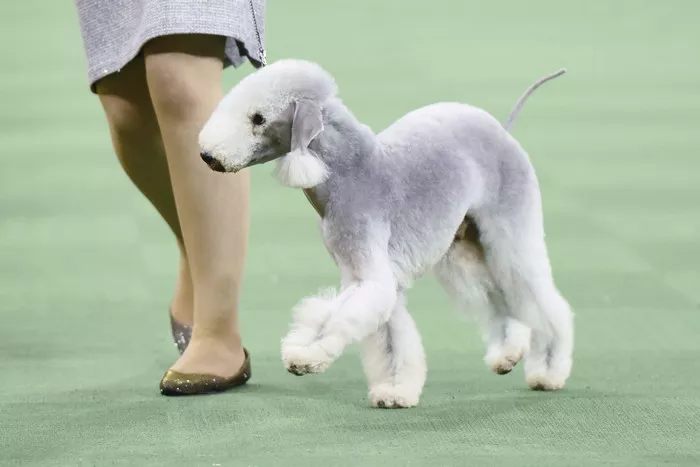The Bedlington Terrier, with its lamb-like appearance and distinctive blue coat, is a breed that often surprises people with its complex personality. While its curly, hypoallergenic fur and gentle expression might suggest a docile companion, this breed has a spirited temperament rooted in its history as a tenacious hunter and versatile working dog. This article explores the unique traits of the blue Bedlington Terrier, focusing on its behavior, adaptability, and care needs.
History and Origins of the Bedlington Terrier
From Working Dog to Companion
The Bedlington Terrier originated in England during the 18th century, bred by miners in the Northumberland region to hunt vermin, such as rats and rabbits. Named after the mining town of Bedlington, these dogs were prized for their speed, agility, and courage. Despite their refined appearance today, their ancestors were rugged working dogs, even participating in underground dogfighting due to their fearless nature. By the late 19th century, the breed gained popularity among aristocrats, transitioning from a utilitarian hunter to a fashionable companion.
Influence on Temperament
This dual heritage—combining grit and elegance—shapes the Bedlington’s temperament. Their hunting instincts remain strong, making them alert and energetic, while their role as companions has honed their loyalty and affection toward families.
Key Traits of the Blue Bedlington Terrier
Confident and Courageous
Bedlington Terriers are known for their boldness. Despite their small to medium size (weighing 8–10 kg and standing 38–43 cm tall), they exhibit remarkable bravery. Historically used to confront rodents and even larger prey, they retain a fearless streak. Owners report that these dogs will defend their territory fiercely if provoked. However, this courage can translate into stubbornness, requiring consistent training to manage.
Playful and Energetic
Bedlingtons thrive on activity. Their history as hunting dogs means they have high energy levels and enjoy games that mimic chasing or problem-solving. Daily exercise, such as long walks or agility training, is essential to prevent boredom-related mischief, like chewing or digging. Their playful nature makes them excellent companions for older children who can engage in interactive play.
Affectionate and Loyal
At home, Bedlingtons are devoted to their families. They form strong bonds with their owners and often seek physical closeness, whether curling up on a lap or following household members from room to room. Their gentle demeanor with children and adaptability to apartment living (with sufficient exercise) make them popular urban pets.
Independent Thinkers
While intelligent, Bedlingtons can be willful. They respond best to positive reinforcement training but may test boundaries if routines are inconsistent. Early socialization is critical to curb territorial behavior toward other dogs, especially in males.
Socialization and Training Needs
Importance of Early Socialization
Unsocialized Bedlingtons may display aggression toward unfamiliar dogs or strangers. Introducing puppies to diverse environments, people, and animals helps mitigate this tendency. For example, visits to dog parks or obedience classes build confidence and reduce reactivity.
Training Strategies
Positive Reinforcement: Reward-based methods, such as treats or praise, work well. Harsh corrections can lead to resistance or anxiety.
Mental Stimulation: Puzzle toys or scent games tap into their hunting instincts, keeping them mentally engaged.
Consistency: Establish clear rules to prevent stubbornness from becoming dominance.
Living with a Blue Bedlington Terrier
Family Compatibility
Bedlingtons suit active households that can meet their exercise needs. They coexist well with children but may chase smaller pets due to their prey drive. Supervision is advised around cats or rabbits.
Grooming Requirements
Their unique coat, which combines soft curls and wiry texture, requires professional grooming every 6–8 weeks to maintain its shape and prevent matting. While low-shedding and hypoallergenic, their fur grows quickly, demanding regular brushing.
Health Considerations
Bedlingtons are prone to copper toxicosis, a genetic liver disorder. Regular veterinary screenings and a diet low in copper are recommended1. Other concerns include patellar luxation and retinal atrophy.
Common Misconceptions
“They’re Just Decorative Dogs”
Though elegant, Bedlingtons are not couch potatoes. Their working heritage means they need both physical and mental challenges to stay content.
“All Blue Bedlingtons Are the Same”
Coat color (blue, liver, or sandy) does not affect temperament. However, improper breeding for color alone can exacerbate health issues.
Conclusion
The blue Bedlington Terrier is a study in contrasts: a gentle-looking dog with a fiery spirit, a loyal family member with an independent streak, and a historical hunter adapted to modern life. Understanding their needs—ample exercise, consistent training, and regular grooming—ensures a harmonious relationship. For those willing to invest time and energy, the Bedlington offers unmatched companionship, blending affection, intelligence, and a touch of mischief.
Related Topics:
DO BEDLINGTON TERRIERS SHED HAIR?
WHAT DO BEDLINGTON TERRIERS LOOK LIKE?
WHERE CAN I BUY A BEDLINGTON TERRIER?


